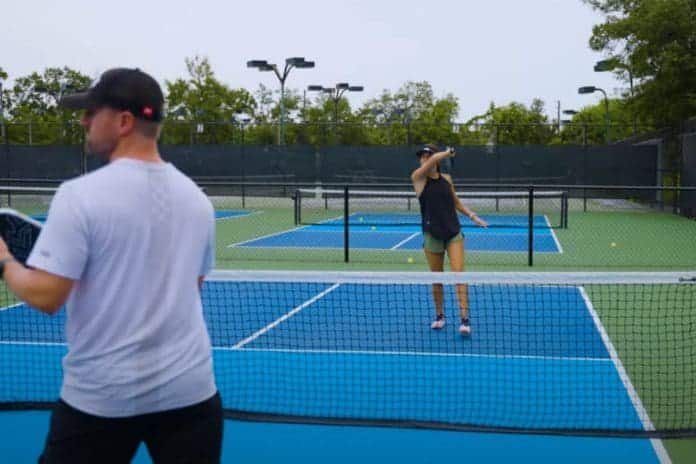Master the Kitchen Line in Pickleball: In pickleball, where to target the opponent at the kitchen line can significantly impact the outcome of a match. While traditional advice may suggest aiming for the hip, shoulder, or backhand, a more effective strategy revolves around understanding the opponent’s paddle position in pickleball and adjusting the attack accordingly.
Opponent’s Paddle, Backhand Heavy
A common stance among recreational players is holding the paddle predominantly on the backhand side. This position covers a larger area but exposes a critical weakness: difficulty transitioning to the forehand during rapid exchanges.
Target Strategy in Pickleball
- Big Target: Forehand side
- Precise Target: Forehand-side armpit
Attacking the forehand-side armpit forces the opponent into an awkward “chicken-wing” position. This often results in a weak counter, providing an opportunity for a follow-up attack.
Opponent’s Paddle, Low / Close to the Hip
Another prevalent stance is holding the paddle low, near the hip, similar to a gunslinger. This position, while providing some coverage, is vulnerable as it complicates effective countering without risking a pop-up.
Target Strategy
- Big Target: Chest
- Precise Target: Shoulder and armpit on the backhand side
By targeting the chest and specifically the shoulder and armpit on the backhand side, the players force their opponent to lift their paddle quickly. This adjustment can result in a pop-up or a weak return, which can be capitalized on with subsequent shots.
Opponent’s Paddle, Out in Front
The optimal position for an opponent is having the paddle outstretched, net-high, and in a neutral stance. This setup allows for quick transitions to forehand and backhand, making it less vulnerable to specific attacks.
Target Strategy
Instead of opting for a speedup, consider executing an aggressive dink to either side of their body. This forces the opponent to lower their paddle, potentially creating an opportunity to strike later in the rally. If the opponent maintains a high paddle position, targeting their partner might be a more strategic move.
Mastering the art of attacking at the kitchen line involves keen observation and adaptability. By analyzing the opponent’s paddle placement and choosing the attacks wisely, the players can gain a significant edge in their pickleball matches.
News in Brief: Master the Kitchen Line in Pickleball
In pickleball, targeting the opponent at the kitchen line can be more effective by understanding their paddle position. For opponents with a backhand-heavy stance, aim for the forehand-side armpit to exploit their awkward positioning. If the paddle is low near the hip, target the chest and backhand-side shoulder to force a weak return.
When the opponent’s paddle is out in front in a neutral stance, opt for aggressive dinks to the sides to force a lower paddle position. This strategic targeting can give the player an advantage by creating weaknesses in their opponent’s defense and setting up opportunities for follow-up shots.
ALSO READ: Tanner Tomassi’s Ultimate Kitchen Line Strategy: Transform Your Play with Pro Insights

